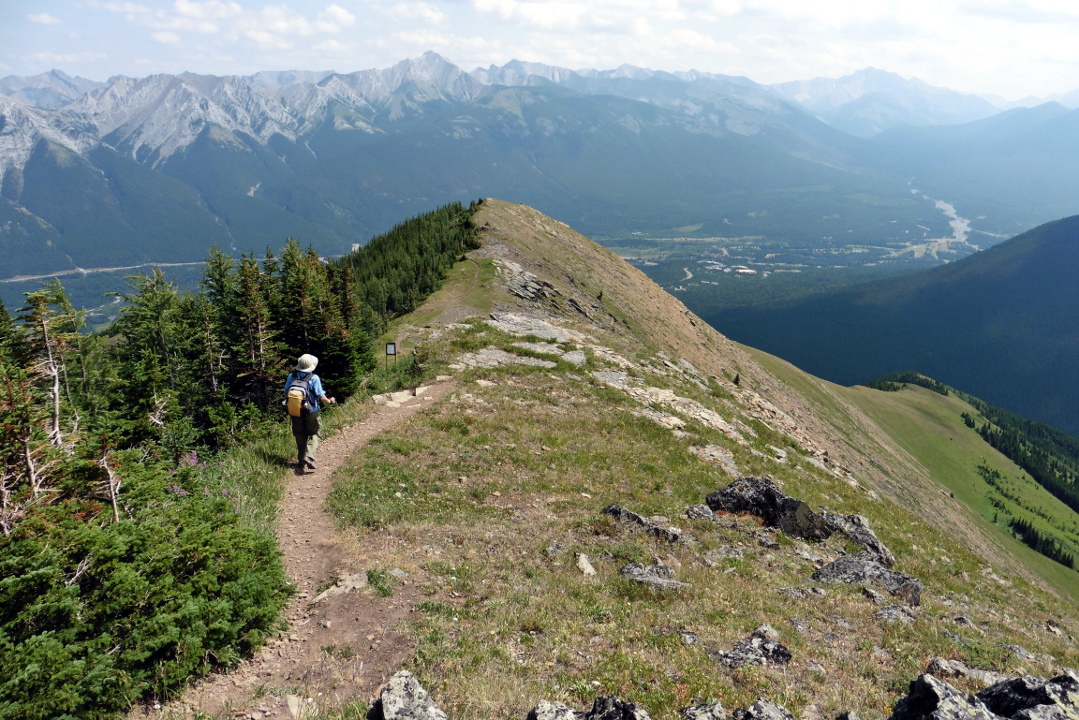Joan and I first drove downhill from the Delta Lodge to the Ribbon Creek Day Use parking area, altitude we must make up on foot. After starting on the trail we encountered this sign.
The first stretch of the trail is broad and crosses and follows various old roads that lead to the Mine Scar, the site of an old open-pit coal mine that operated until 1952. Many of these lower-altitude trails show damage from the June 2013 floods.
The path grew steeper and we steadily gained altitude until the grassy sweep of the replanted strip mine opened up in front.
And we continued up. In favored spots flowers were blooming.
Moisture from heavy showers the evening before has generated low clouds this morning. Here, we look back after half an hour of switchback climbing through the coal scar meadows. The top of Mount Kidd, right, sports a grey wreath.
And we continued climbing. Eventually the meadows faded and the terrain became rockier.
Here is some of the gear.
Further on, there is a trail camera. Smile!
It was time for a chocolate bar, and our first sit of the hike. To the northwest, the last bump of Olympic Summit provided the foreground for rising clouds and mists.
The Centennial Ridge trail continues along the distant ridgeline.
Fortified by our chocolate, we continued to the high point of Olympic Summit and gazed across. The Ribbon Creek valley is on the far left, and the Memorial Lakes are just left of center.
Our guidebook says that many people climb this far and then turn around, and emphasizes that this is a mistake. The trail stretches on towards Mount Allan, 10,860', still in the clouds.
Five minutes down the trail we encountered a guardian.
The trail descended (boo) and then began climbing again, weaving amongst the rocks.
The trail moved to the west side of the ridgeline and we entered the Rock Garden, a compelling reason to hike beyond the Olympic Summit. Mount Allan stubbornly held onto its clouds.
This is the view back towards Olympic Summit.
A plaque located five minutes on explains the origins of the trail.
The geology here has preserved a line of harder rock, tilted almost vertical by tectonic collisions. This line has eroded into a marvelous set of teeth.
It's difficult to comprehend the scale unless you're standing there.
This pika was wondering what we were up to.
I could have easily spent an hour here, photographing the stones from different angles and in different light.
And these.
Even up here, flowers take root in the stony soil, including dwarf larkspur and alpine forget-me-not.
We also saw a hoary marmot dashing about on these slopes.
Beyond the rock garden there's a short stretch of route-finding through rocks, which I'll show on the return journey, and then more trail. Joan and I reached a saddle in the ridgeline before the final climb to Mount Allan, looked at our watches, and decided to lunch and turn around. I've marked up this Google Maps image to show the trail parking, right, and our saddle. Mount Allan is in the upper left corner.
I took this panoramic shot from the saddle, looking west. Our entry route is on the extreme left, and the way to Mount Allan, finally out of the clouds, is on the right.
Here's a closer look at the route to the summit. Joan and I were tempted, oh we were tempted, to go on. But time was short at our hiking speed, and there was a lot of knee-pounding downhill to come. Reaching the saddle wasn't too shabby for a couple living in Ohio.
An account from the accomplished hiking blogger Barry, a Calgary native who did reach the summit, is here.
A full zoom with the camera captured this image of one of the Memorial Lakes, far across the valley.
We began to retrace our steps. This red flower caught my eye; it turns out to the ledge stonecrop, or Rhodiola integrifolia.
Approaching the rock garden again, this time from the north.
This rock wall slowed us on our way up. We briefly tried the east side, but it quickly broke into a pathless jumble. Here, Joan is approaching the point on the west side where we found the best way up and down. There was another point where down would have been easy, but back up problematic.
I paused for a panoramic view when we returned to the top of Olympic Summit. The clouds have lifted and the light is now behind me as I gaze down the ridgeline of the "summit."
After a few minutes hiking down the ridgeline we spotted a horned lark.
At the end of the ridge the path dove down various rock faces, and then opened up again.
We were walking through a study plot. Joan and I had also seen this sign when first entering the coal scar meadow.
We paused on some rocks here for a final snack break.
The fireweed still had some lovely blooms.
Here is a clear view of the trail through the coal scar meadow. We were glad for our trekking poles; it's even more precipitous than it looks.
My final photo of this hike shows a butterfly checking us out.
After a long, footsore tromp down the final segments we returned to the parking area. In particular, Joan's big toe had been troubling her for the last part of the descent. Intellectually we appreciated the correctness of our decision to turn about at the saddle, as much as our hearts would have enjoyed the view from Mount Allan.








































No comments:
Post a Comment
Comments may not appear immediately as they are moderated by the author to eliminate spam. Please, no commercial links!